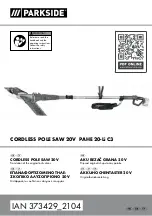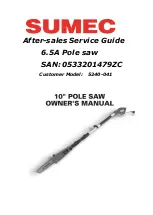
3
• Do not operate this tool for long periods of time.
Vibration caused by the
operating action of this tool may cause permanent injury to fingers, hands, and
arms. Use gloves to provide extra cushion, take frequent rest periods, and limit
daily time of use.
WARNING: ALWAYS USE SAFETY GLASSES.
Everyday eyeglasses are NOT safety
glasses. Also use face or dust mask if cutting operation is dusty. ALWAYS WEAR
CERTIFIED SAFETY EQUIPMENT:
• ANSI Z87.1 eye protection (CAN/CSA Z94.3),
• ANSI S12.6 (S3.19) hearing protection,
• NIOSH/OSHA/MSHA respiratory protection.
WARNING:
Some dust created by power sanding, sawing, grinding, drilling, and
other construction activities contains chemicals known to cause cancer, birth defects
or other reproductive harm. Some examples of these chemicals are:
• lead from lead-based paints,
• crystalline silica from bricks and cement and other masonry products, and
• arsenic and chromium from chemically-treated lumber (CCA).
Your risk from these exposures varies, depending on how often you do this type of
work. To reduce your exposure to these chemicals: work in a well ventilated area, and
work with approved safety equipment, such as those dust masks that are specially
designed to filter out microscopic particles.
•
Avoid prolonged contact with dust from power sanding, sawing, grinding,
drilling, and other construction activities. Wear protective clothing and wash
exposed areas with soap and water.
Allowing dust to get into your mouth, eyes,
or lay on the skin may promote absorption of harmful chemicals.
WARNING:
Use of this tool can generate and/or disburse dust, which may cause
serious and permanent respiratory or other injury. Always use NIOSH/OSHA approved
respiratory protection appropriate for the dust exposure. Direct particles away from
face and body.
CAUTION: When not in use, place tool on its side on a stable surface where it
will not cause a tripping or falling hazard.
Some tools with large battery packs will
stand upright on the battery pack but may be easily knocked over.
CAUTION:
Wear appropriate hearing protection during use.
Under some
conditions and duration of use, noise from this product may contribute to hearing
loss.
• The label on your tool may include the following symbols. The symbols and
their definitions are as follows:
V ................. volts
A ...............amperes
Hz ............... hertz
W ..............watts
min ............. minutes
...........alternating current
.......... direct current
no ..............no load speed
.............. Class I Construction
.............earthing terminal
...................
(grounded)
.............safety alert symbol
............... Class II Construction
…/min .......revolutions per minute
...................
(double insulated)
BPM ..........beats per minute
Important Safety Instructions for Battery Chargers
SAVE THESE INSTRUCTIONS:
This manual contains important safety instructions for
battery chargers.
• Before using charger, read all instructions and cautionary markings on charger,
battery pack, and product using battery pack.
WARNING:
Shock hazard. Do not allow any liquid to get inside charger.
CAUTION:
Burn hazard. To reduce the risk of injury, charge only D
E
WALT batteries.
Other types of batteries may burst causing personal injury and damage.
CAUTION:
Under certain conditions, with the charger plugged in to the power
supply, the charger can be shorted by foreign material. Foreign materials of a
conductive nature such as, but not limited to, steel wool, aluminum foil, or any
buildup of metallic particles should be kept away from charger cavities. Always
unplug the charger from the power supply when there is no battery pack in the
cavity. Unplug charger before attempting to clean.
•
DO NOT attempt to charge the battery pack with any chargers other than the
ones in this manual.
The charger and battery pack are specifically designed to
work together.
•
These chargers are not intended for any uses other than charging D
E
WALT
rechargeable batteries.
Any other uses may result in risk of fire, electric shock
or electrocution.
•
Do not expose charger to rain or snow.
•
Pull by plug rather than cord when disconnecting charger.
This will reduce
risk of damage to electric plug and cord.
Содержание DC305-XE
Страница 1: ...DC305 XE HEAVY DUTY 36V CORDLESS RECIPROCATING SAW INSTRUCTION MANUAL ...
Страница 2: ......
Страница 14: ......
Страница 15: ......


































